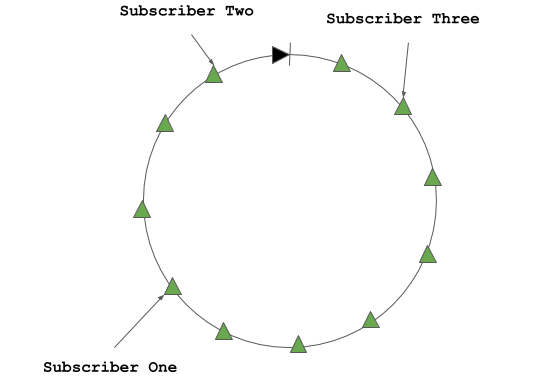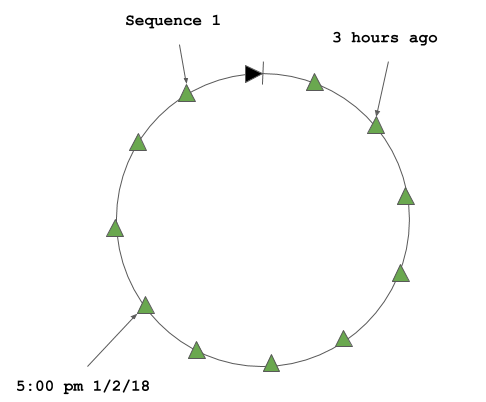NATS Streaming
Where NATS provides at most once quality of service, streaming adds at least once. Streaming is implemented as a request-reply service on top of NATS. Streaming messages are encoded as protocol buffers, the streaming clients use NATS to talk to the streaming server. The streaming server organizes messages in channels and stores them in files and databases. ACKs are used to insure delivery in both directions.
Sometimes the maintainers will refer to NATS as "nats core" and streaming as "stan" or "streaming."
Messages to the streaming service are opaque byte arrays, just as they are with NATS. However, the streaming server protocol uses protocol buffers to wrap these byte arrays. So if you listen to the NATS traffic the messages will appear as protocol buffers, while the actual data sent and received will simply be byte arrays.
NATS streaming uses the concept of a channel to represent an ordered collection of messages. Clients send to and receive from channels instead of subjects. The subjects used by the streaming libraries and server are managed internally. Channels do not currently support wildcard. Channels aren’t raw subjects. Streaming isn’t raw NATS. The streaming libraries hide some of the differences.
Think of channels as a ring buffer. Messages are added until the configured limit is reached. Old messages are removed to make room for new ones. Old messages can expire, based on configuration. Subscriptions don’t affect channel content. Subscriptions are like a cursor on the ring buffer.
Positions in the channel are specified in multiple ways:
- Sequence number - counting from 1
- Time
- Time delta (converted to time on client)
New subscriptions can also specify last received to indicate they only want new messages. Sequence numbers are persistent, when message #1 goes away the oldest message is message #2. Trying to go to a position before the oldest message will be moved to the oldest message.
Subscription Types
NATS Streaming supports several types of subscriptions:
- Regular
- Durable
- Queue
- Durable/Queue
Regular subscriptions pick the location of their channel position on creation and it is stored while the subscriber is active. Durable subscriptions store their position in the streaming server. Queue subscriptions share a channel position. Durable/Queue subscriptions share a channel position stored in the server. All subscriptions can be configured with a starting position, but only new durable subscriptions and new regular subscriptions respect the request.
All subscriptions define their position on creation. Regular subscriptions lose their position if the application crashes, the app disconnects or they unsubscribe. Durable subscriptions maintain their position through disconnect, subscriber close, but not through unsubscribe. The position on reconnect comes from the server not the options in both cases. Queue subscriptions share a position. Regular queue subscriptions lose their position on the last disconnect/unsubscribe. Durable queue subscriptions maintain their position through disconnect, but not through the last unsubscribe. Positions provided in options are ignored after the position is set.
Acknowledgements
In order to implement at least once delivery NATS streaming uses ACK messages for publishers and subscribers. Each message sent from the streaming server to the client must be acknowledged or it will be re-delivered. Developers must switch their mind set. The same message can arrive more than once. Messages should be idempotent. The client libraries can help with ACKs. Subscriptions can use manual or automatic ACKs. Manual ACKs are safer, since the program controls when they happen. An ACK wait setting is used to define the timeout before an ACK is considered missing.
Ack wait = 10s means that the server won’t redeliver for at least 10s
Using ACKs for each message sent can be a performance hit - round trip per message. NATS streaming allows subscriptions to set a max in flight value. Max in flight determines how many unacknowledged messages can be sent to the client. Ack Wait is used to decide when the ACK for a message has failed and it needs to be redelivered. New and redelivered messages are sent upon availability, in order.
Messages are sent in order, when they are available:
- Max inflight = 2
- Send msg 1 and msg 2
- ACK 2
- Message 3 arrives at the server
- Send message 3 (since it is available)
- When Ack wait expires, msg 1 is available
- Send msg 1 (1 and 3 are in flight)
The streaming server sends available messages in order, but 1 isn’t available until its Ack wait expires. If max in flight = 1 then only 1 message is on the wire at a time, it will be re-sent until it is acknowledged. Re-delivered messages will not come out of order in this situation.
Setting max in flight to a number greater than 1 requires some thought and foresight to deal with redelivery scenarios.
Max in flight is a per-subscription setting. In the case of queue subscribers, each client can set the value. Normally, each client will use the same value but this is not a requirement.
NATS streaming uses acknowledgements on the sending side as well as the subscribing side. The streaming server acknowledges messages it receives and has persisted. A maximum in flight setting is used for publishers. No more than max in flight can be on their way to the server at one time. The library may provide various mechanisms to handle publisher ACKs. The application must manage redelivery to the server.

